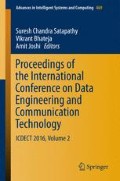Abstract
The Android operating system has a large market share. The number of new malware on Android is increasing much recently. Android malware analysis includes static analysis and dynamic analysis. Limitations of static analysis are the difficulty in analyzing the malware using encryption techniques, to confuse the source, and to change behavior itself. In this paper, we proposed a hybrid analysis method, named NeSeDroid. This method used static analysis to detect the sensitive resource accessing. It also used dynamic analysis to detect sensitive resource leakage, through Internet connection. The method is tested on the list of applications which are downloaded from Android Apps Market, Genome Malware Project dataset and our additional samples in DroidBench dataset. The evaluation results show that the NeSeDroid has the high accuracy and it reduces the rate of fail positive detection.
Access this chapter
Tax calculation will be finalised at checkout
Purchases are for personal use only
References
Corporation, I.D. 2015; Available from: http://www.idc.com/prodserv/smartphone-os-market-share.jsp.
F-Secure. 2014; Available from: https://www.f-secure.com/documents/996508/1030743/Mobile_Threat_Report_Q1_2014.pdf.
Sanz, B., et al., MAMA: Manifest Analysis For Malware Detection In Android. Cybern. Syst., pp. 469–488 (2013).
Moonsamy, V., et al., Contrasting Permission Patterns between Clean and Malicious Android Applications, in Security and Privacy in Communication Networks, T. Zia, et al., Springer International Publishing. pp. 69–85 (2013).
Gascon, H., et al., Structural detection of android malware using embedded call graphs, in Proceedings of the 2013 ACM workshop on Artificial intelligence and security. ACM: Berlin, Germany. pp. 45–54 (2013).
Li, L., et al., IccTA: Detecting Inter-Component Privacy Leaks in Android Apps, in The 37th International Conference on Software Engineering (ICSE). Firenze, Italy (2015).
Li, L., et al. Automatically Exploiting Potential Component Leaks in Android Applications. in Trust, Security and Privacy in Computing and Communications (TrustCom), 2014 IEEE 13th International Conference on. (2014).
Aafer, Y., W. Du, and H. Yin, DroidAPIMiner: Mining API-Level Features for Robust Malware Detection in Android, in Security and Privacy in Communication Networks, T. Zia, et al., Springer International Publishing. pp. 86–103 (2013).
Arzt, S., et al., FlowDroid: precise context, flow, field, object-sensitive and lifecycle-aware taint analysis for Android apps, in Proceedings of the 35th ACM SIGPLAN Conference on Programming Language Design and Implementation. ACM: Edinburgh, United Kingdom. pp. 259–269 (2014).
Bagheri, H., et al., COVERT: Compositional Analysis of Android Inter-App Permission Leakage. Software Engineering, IEEE Transactions on, pp. 1–1 (2015).
Dini, G., et al., MADAM: a multi-level anomaly detector for android malware, in Proceedings of the 6th international conference on Mathematical Methods, Models and Architectures for Computer Network Security: computer network security. Springer-Verlag: St. Petersburg, Russia. pp. 240–253 (2012).
Shabtai, A., et al., “Andromaly”: a behavioral malware detection framework for android devices. J. Intell. Inf. Syst., pp. 161–190 (2012).
Zheng, C., et al., SmartDroid: an automatic system for revealing UI-based trigger conditions in android applications, in Proceedings of the second ACM workshop on Security and privacy in smartphones and mobile devices. ACM: Raleigh, North Carolina, USA. pp. 93–104 (2012).
Enck, W., et al., TaintDroid: an information-flow tracking system for realtime privacy monitoring on smartphones, in Proceedings of the 9th USENIX conference on Operating systems design and implementation. USENIX Association: Vancouver, BC, Canada. pp. 1–6 (2010).
Zaman, M., et al. Malware detection in Android by network traffic analysis. in Networking Systems and Security (NSysS) (2015).
Wu, X., et al., Detect repackaged Android application based on HTTP traffic similarity. Security and Communication Networks, (2015).
Zheng, M., M. Sun, and J.C.S. Lui, DroidRay: a security evaluation system for customized android firmwares, in Proceedings of the 9th ACM symposium on Information, computer and communications security. ACM: Kyoto, Japan. pp. 471–482 (2014).
Feldman, S., D. Stadther, and W. Bing. Manilyzer: Automated Android Malware Detection through Manifest Analysis. in Mobile Ad Hoc and Sensor Systems (MASS), IEEE 11th International Conference on. (2014).
Mobile security threat report. 2015 [cited 2015 April 10]; Available from: http://www.sophos.com/en-us/threat-center/mobile-security-threat-report.aspx.
Feizollah, A., et al. Comparative study of k-means and mini batch k-means clustering algorithms in android malware detection using network traffic analysis. in Biometrics and Security Technologies (ISBAST), 2014 International Symposium on. (2014).
Jun, L., et al. Research of android malware detection based on network traffic monitoring. in Industrial Electronics and Applications (ICIEA), 2014 IEEE 9th Conference on. (2014).
Shabtai, A., et al., Mobile malware detection through analysis of deviations in application network behavior. Computers & Security, pp. 1–18 (2014).
Malware Domain Blocklist. [cited 2015 July 10]; Available from: http://www.malwaredomains.com/?page_id=23.
Android Malware Genome Project 2015; Available from: http://www.malgenomeproject.org/.
Rasthofer, S., S. Arzt, and E. Bodden, A Machine-learning Approach for Classifying and Categorizing Android Sources and Sinks. (2014).
ApkTool. 2015; Available from: https://github.com/iBotPeaches/Apktool.
dex2jar: Tools to work with android .dex and java .class files 2015 [cited 2015 May 20]; Available from: https://github.com/pxb1988/dex2jar.
WireShark. 2015 [cited 2015 May 20]; Available from: https://www.wireshark.org/.
Android-x86 Project - Run Android on Your PC. 2015 [cited 2015 May 10]; Available from: http://www.android-x86.org/.
Ubuntu 12.04.5 LTS (Precise Pangolin). 2015 [cited 2015 May 2]; Available from: http://releases.ubuntu.com/12.04/.
Acknowledgments
Our thanks to professors of Science and Technology faculty of HoaSen University and professors of Telecommunication and Networking faculty of University of Science (Vietnam National University–Ho Chi Minh City) who have many positive comments and value reviews.
Author information
Authors and Affiliations
Corresponding author
Editor information
Editors and Affiliations
Rights and permissions
Copyright information
© 2017 Springer Science+Business Media Singapore
About this paper
Cite this paper
Cam, N.T., Phuoc, N.C.H. (2017). NeSeDroid—Android Malware Detection Based on Network Traffic and Sensitive Resource Accessing. In: Satapathy, S., Bhateja, V., Joshi, A. (eds) Proceedings of the International Conference on Data Engineering and Communication Technology. Advances in Intelligent Systems and Computing, vol 469. Springer, Singapore. https://doi.org/10.1007/978-981-10-1678-3_3
Download citation
DOI: https://doi.org/10.1007/978-981-10-1678-3_3
Published:
Publisher Name: Springer, Singapore
Print ISBN: 978-981-10-1677-6
Online ISBN: 978-981-10-1678-3
eBook Packages: EngineeringEngineering (R0)

